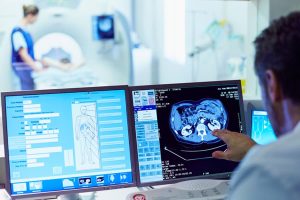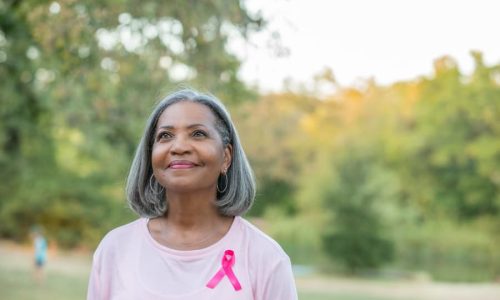
PSMA Therapy for Metastatic Prostate Cancer
A targeted, infused therapy that delivers radiation directly to cancerous cells has been shown to extend survival in many patients with metastatic prostate cancer. The
HIPAA Alert: Potential Data Breach Learn More
Questions on Oncology, Hematology and/or Infusion Clinical Services due to COVID-19 Crisis – CALL 833-698-1623
Important Information for Our Patients Regarding the Coronavirus.
RCCA Providing Area Cancer Patients with Access to Care During Coronavirus Outbreak
RCCA Offering Patients Virtual Visits During Coronavirus Pandemic
If you or a loved one has been diagnosed with breast cancer, you might have heard the term “triple-negative” breast cancer. The American Cancer Society defines triple-negative breast cancer as an aggressive cancer type that accounts for 10 percent to 15 percent of all breast cancer cases.
But what exactly does “triple negative” mean? Regional Cancer Care Associates (RCCA) is a trusted provider for patients seeking comprehensive cancer care. Our oncologists and hematologists specialize in providing advanced treatments for hematologic conditions and all kinds of cancer, including triple-negative breast cancer. Here, we explain what triple-negative breast cancer is, as well as what patients and their loved ones need to know about the condition.

If you or a loved one has been diagnosed with breast cancer, you might have heard the term “triple-negative” breast cancer. The American Cancer Society defines triple-negative breast cancer as an aggressive cancer type that accounts for 10 percent to 15 percent of all breast cancer cases.
But what exactly does “triple negative” mean? Regional Cancer Care Associates (RCCA) is a trusted provider for patients seeking comprehensive cancer care. Our oncologists and hematologists specialize in providing advanced treatments for hematologic conditions and all kinds of cancer, including triple-negative breast cancer. Here, we explain what triple-negative breast cancer is, as well as what patients and their loved ones need to know about the condition.
When pathologists examine tissue from a breast biopsy and identify cancerous cells, they also characterize the cells to determine which particular type of breast cancer a patient has. This involves performing an immunohistochemistry test to look for the presence of different receptors. Receptors are molecules – often proteins– inside or on the surface of a cell that bind to a specific substance and cause a particular effect in the cell. Three receptors are known to fuel breast cancer growth: the hormone receptors estrogen (ER) and progesterone (PR) and the human epidermal growth factor receptor 2 (HER2). If test results come back “negative” for all three receptors – meaning they aren’t present in the cancerous tissue examined – the patient is diagnosed with triple-negative breast cancer.
Triple-negative breast cancer grows and spreads more quickly (i.e., is more aggressive) than other breast cancer types, so it is more likely to spread beyond the breast and to reoccur after treatment. Additionally, many breast cancer therapies available today are designed to work against a particular type of receptor-positive breast cancer, such as HER2 breast cancer. Because women with triple-negative breast cancer do not have the receptors that those therapies target, those medications are not effective treatment options for them.
Early signs and symptoms of triple-negative breast cancer are similar to those of other common breast cancer types. Women should be familiar with how their breasts look and feel normally, so that they’ll notice changes that are potentially indicative of breast cancer.
A common warning sign for any type of breast cancer is the emergence of a lump or mass. Some masses can be painless and hard with irregular edges, while others can be round, soft, tender, or even painful.
Other symptoms associated with triple-negative breast cancer include:
While many of these symptoms are also associated with several benign (noncancerous) breast conditions, women who notice one or more of these symptoms should consult a health care professional.
Factors associated with an increased e risk for triple-negative breast cancer include:
While the risk for other forms of breast cancer increases with age, triple-negative breast cancer is more commonly seen in premenopausal women. Women younger than age 40 are at the highest risk.
Women from certain ethnic backgrounds, such as African American and Hispanic women, are at heightened risk of triple-negative breast cancer. Research shows approximately 20 percent to 40 percent of breast cancers diagnosed in African American women are triple-negative.
Evidence shows that mutations (changes) in genes such as BRCA1 are strongly associated with triple-negative breast cancer.
Early detection of any form of cancer is critical to achieving a favorable outcome, but it is especially important for triple-negative breast cancer. Because this cancer type is more aggressive than other breast cancers, the prognosis (outlook) tends to be somewhat worse. However, if the disease is detected in its early stages, when the cancer is limited to the breast tissue, the outlook for successful treatment is better than when the cancer has spread. Health care providers use five stages to categorize all forms of breast cancer. As outlined by the American Society of Clinical Oncology on its Cancer.net website, the stages of breast cancer are as follows:
Breast cancer in its earliest stage consists of pre-invasive or non-invasive cancer cells that are present in the breast ducts but have not spread to nearby tissue.
There are two groups are Stage II breast cancer.
There are three subgroups of Stage III breast cancer.
The tumor can be any size and has spread to other organs, such as the bones, lungs, brain, liver, distant lymph nodes, or chest wall.
Treatment for triple-negative breast cancer differs from treatment of other breast cancers because fewer options are available. Triple-negative breast cancer cells do not have the receptors that respond to hormone therapy and anti-HER2 drugs , so other approaches must be used.
Chemotherapy and surgery often are recommended for patients with triple-negative breast cancer. Chemotherapy uses powerful medications to attack and kill cancer cells or prevent them from spreading. By reducing the size of tumors, these drugs may also alleviate pain and other symptoms. Chemotherapy may be administered orally or intravenously.
The precise chemotherapy prescribed depends on the patient’s overall health, how far the cancer has spread, and other factors. In some cases, chemotherapy might be administered first – either alone or with an immunotherapy – to shrink a large tumor, followed by surgery. In other instances, chemotherapy may be recommended after surgery to kill remaining leftover cells and reduce the chances of reoccurrence.
Radiation therapy after surgery is another approach. Radiation therapy uses high-energy rays to kill cancer cells and prevent their spread. Patients may undergo external or internal radiation or receive radioactive medications. Use of radiation therapy in triple-negative breast cancer can help eliminate the threat of reoccurrence.
For cases in which cancer has spread to other parts of the body, immunotherapy combined with chemotherapy might be considered. Immunotherapy enhances the body’s immune system, empowering it to recognize and destroy cancer cells. Women who have a BRCA genetic mutation may be candidates for treatment with a type of targeted therapy called PARP inhibitors. Another therapy from a relatively newer class of drugs called antibody-drug conjugates may be an option for some women with advanced triple-negative breast cancer following treatment with other medications.
The important thing to note is that while women with triple-negative breast cancer are not candidates for the therapies used to treat receptor-positive cancers, several newer agents are available to treat their cancers. Along with surgery, chemotherapy, and radiation therapy, these medications provide oncologists with a greater ability than ever before to personalize each patient’s treatment in order to achieve the best possible outcome.
Side effects related to triple-negative breast cancer treatment are common. Each patient reacts differently to each treatment, but side effects can include:
If side effects occur during treatment, an oncologist or oncology nurse will provide advice or treatment to help alleviate symptoms. If side effects become severe, the oncologist may consider changing treatment approaches.
The experienced medical oncologists and hematologists of RCCA provide personalized, evidence-based treatment for patients with triple-negative breast cancer and other cancer types. The care RCCA provides is both comprehensive and compassionate, and the care team also offers ongoing emotional support to patients living with breast cancer and their families. RCCA also offers patients access to clinical trials for breast cancer.
RCCA has 22 community-based, conveniently located treatment centers in New Jersey, Connecticut, Maryland, and the Washington, DC area. To learn more about triple-negative breast cancer or to schedule an appointment, contact our oncology team.
For more information or to schedule an appointment,
call 844-346-7222. You can also schedule an appointment by calling the RCCA location nearest you.

A targeted, infused therapy that delivers radiation directly to cancerous cells has been shown to extend survival in many patients with metastatic prostate cancer. The

Patients receiving treatment from Regional Cancer Care Associates in Moorestown are in good hands. Five of its physicians — Dr. Seth Berk, Dr. Maurice Cairoli, Dr.

The world of cancer treatment is rapidly evolving. New therapies are being discovered, and existing ones have improved, resulting in better patient outcomes. Regional Cancer

Regional Cancer Care Associates is one of fewer than 200 medical practices in the country selected to participate in the Oncology Care Model (OCM); a recent Medicare initiative aimed at improving care coordination and access to and quality of care for Medicare beneficiaries undergoing chemotherapy treatment.